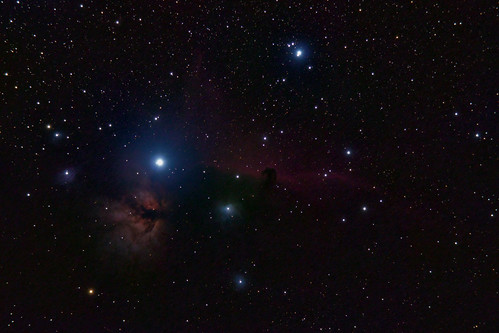17 January 2020, 21:45 – 00:45
Cold – but not excessively so for mid-January. Some cloud moving from the west which delayed my planned start time by 45 minutes. Condensation on lenses towards end of session.
Seeing: Good
Transparency: Average
I left the 13mm Ethos (92x) in the focuser for the entire session as I didn’t know how long I was going to get until it clouded over again – and I didn’t want to waste precious time changing eyepieces. As it turned out the sky was still clear when the moon rose later on.
After spending some time on M42 (where else?) I moved north to the area around Alnitak and Sigma Orionis (a lovely multiple star system in its own right). The Horsehead Nebula was too faint to see (of course), but it did show up in images I took with the TV60 and an unmodded DSLR on Wednesday night (but only after extensive processing).
NGC 2023, emission nebula / reflection nebula, Orion
Visible as a fuzzy star with direct vision; size of nebulosity increasing with averted vision.
IC 435, reflection nebula, Orion
Like a smaller, fainter sibling of NGC 2023. Fairly obvious now I know it’s there, but easily overlooked – especially with all the other distracting objects nearby.
NGC 2024, Flame Nebula in Orion
Just faintly visible tonight. I don’t think the Ethos is the best eyepiece for this object; the super-wide field of view makes it almost impossible to separate the nebula from the glare of Alnitak.
NGC 1535, planetary nebula, Eridanus
Little blue-grey disc of light at 92x (unfiltered). It was already well past the meridian when I tracked it down, but it was quite obvious despite the light pollution. Averted vision suggested an extended outer fuzz. Need to catch this one earlier in the evening.
NGC 2324, open cluster, Monoceros
Loose group of stars shaped a bit like a letter K. Moderately bright.
NGC 2301, open cluster, Monoceros
Rich, condensed cluster (visible in finderscope). Bright tail of stars to the south, fainter one to the east. Bright yellow star near centre.
NGC 2254, open cluster, Monoceros
Very small “fuzz”, four stars resolved with direct vision. Oddly, looked much the same using averted vision. One of the two clusters plotted in the Pocket Sky Atlas lurking between the Christmas Tree and the Rosette.
NGC 2251, open cluster, Monoceros
Elongated “fang” of stars, forming a sort of bugle/horn outline. Larger, brighter than 2254. Second of the two PSA clusters lurking between the Christmas Tree and the Rosette.
NGC 2244, OC, Monoceros
The central cluster of the Rosette. Well framed in the Ethos, but magnification a little too high to separate the nebula from the surrounding star-fields. Might be worth trying this again with one of the filters.
NGC 2261, Hubble’s Variable Nebula, Monoceros
Bright little fan-shaped nebula. Bright spot or condensation at apex.
NGC 2264, Christmas Tree Cluster, Monoceros
Beautifully framed in the Ethos. Bright blue star at base (S Monocerotis) with fainter close companion to NE, both surrounded by haze/halo. Couldn’t see any other nebulosity on this occasion.
At around 22:45, while taking a break from the eyepiece, I saw two meteors travelling in opposite directions, one after the other in the space of a couple of seconds. The second one travelled from the east and passed directly in front of M44 (the Beehive Cluster). What a photo that would have made…
M41, open cluster, Canis Major
Looked good in the Ethos despite the low altitude. Bright stars, loosely concentrated. Arranged in a wavy “cross” shape, like a flattened hour-glass. Bright orange star near centre.
It’s worth noting here that the 9x50 finder really helped me locate the following open clusters (as well as the previous objects noted in Monoceros). I’ve struggled with these constellations in the past due to their southerly declination and absence of bright stars (my old Vixen 102 had a 6x30 finder), but the new finder showed me all the stars I needed to see – and often showed the clusters themselves.
M50, open cluster, Monoceros
Rich arrow-shaped cluster pointing west. Bright yellow-orange star on southern corner.
M48, open cluster, Hydra
Rich, large, loose cluster of bright stars – a “typical” Messier cluster if there is such a thing. Curving line of stars to east, close double near centre.
M47, open cluster, Puppis
Rich mixture of bright and faint stars – very attractive in the Ethos. Brightest members form a triangle, with prominent doubles at east and west corners angled towards each other (the eastern pair of equal brightness). This cluster is so prominent in the finder, I wondered if it might be visible to the naked eye; it is – with averted vision.
M46 & NGC 2438, open cluster + planetary nebula, Puppis
Rich cluster of moderately bright stars; a short hop east from M47. (Both clusters look great in the Ethos.) NGC 2438 immediately obvious as a grey disc of light on northern edge of cluster. Bright star on eastern edge of nebula, fainter one shining through. Probably the highlight of the evening.
NGC 2423, open cluster, Puppis
Moderately rich cluster overshadowed by nearby Messiers. Close double on western edge.
NGC 2396, open cluster, Puppis
Sparse cluster of stars just south of a bright double. The double was probably more interesting than the cluster: pale yellow primary, blue secondary (west), and a fainter third star southeast.
NGC 2374, open cluster, Canis Major
Small cluster, faint stars. Averted vision suggests underlying richness.
NGC 2360, open cluster, Canis Major
(Caldwell 58) Rich little cluster, well worth tracking down. Stars arranged in gently curving chains. Straight line of faint stars leading to bright star on NE edge of cluster.
M93, open cluster, Puppis
Another rich little cluster of bright stars, looked good in the XT10 despite low altitude (-24 degrees declination). Central triangle of stars surrounded by loose assembly of bright stars on either side.


No comments:
Post a Comment